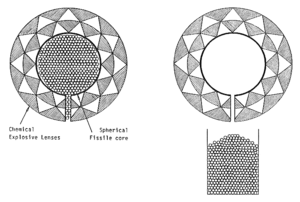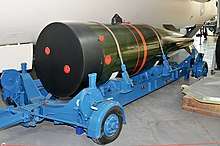Yellow Sun (nuclear weapon)
Yellow Sun was the first British operational high-yield strategic nuclear weapon. The name refers only to the outer casing; the warhead (or physics package) was known as "Green Grass" in Yellow Sun Mk.1 and "Red Snow" in Yellow Sun Mk.2.
| Yellow Sun | |
|---|---|
A Yellow Sun at the Royal Air Force Museum Cosford (2011) | |
| Type | Nuclear weapon |
| Place of origin | United Kingdom |
| Specifications | |
| Mass | 7,250 pounds (3,290 kg) |
| Length | 21 feet (6.4 m) |
| Diameter | 4 feet (1.2 m) |
| Filling | Uranium – Green Grass warhead Plutonium/Hydrogen – Red Snow warhead |
| Blast yield | 400 kt (1,700 TJ) Green Grass warhead 1.1 Mt (4.6 PJ) Red Snow warhead |
Yellow Sun was designed to contain a variety of warheads. The initial plan was that it would carry an alarm-clock-type warhead known as "Green Bamboo", and then replace it with a true thermonuclear warhead known as "Granite". After signing a technology agreement with the US, Green Bamboo was abandoned and replaced by a very large pure-fission design, "Green Grass". Granite was later abandoned in favour of the Red Snow, based on a US design.
A unique feature of the Yellow Sun casing was its completely flat nose. This provided two benefits, one was that the drag allowed the bomb to fall behind the bomber a safe distance before detonation, and the other was that it did not generate the complex pattern of shock waves that a classically curved nose created, which made it difficult to measure altitude barometrically.
Mark 1 began to enter service in 1959, replacing the massive Blue Danube over the next year. Mark 2 began to replace it in 1961. Beginning in 1966, Yellow Sun was replaced by the WE.177, based on another US design.
Design

The casing was around 21 feet (6.4 m) long, and 48 inches (1.2 m) in diameter. The Mark 1 version with the Green Grass warhead weighed 7,250 pounds (3,290 kg). The Mk.2 version with the lighter 1,700 pounds (770 kg)[1] Red Snow warhead had ballast added to maintain overall weight, ballistic and aerodynamic properties, and avoid further lengthy and expensive testing, and changes to the electrical power generating and airburst fuze.
Unlike contemporary United States bombs of similar destructive power, Yellow Sun did not deploy a parachute to retard its fall. Instead, it had a completely flat nose which induced drag, thereby slowing the fall of the weapon sufficiently to permit the bomber to escape the danger zone. Additionally, the blunt nose ensured that Yellow Sun did not encounter the transonic/supersonic shock waves which had caused many difficulties with barometric fuzing gates which had plagued an earlier weapon, Blue Danube.
Electrical power was supplied by duplicated ram-air turbines located behind the twin air intakes in the flat nose. The earlier Blue Danube design had relied on lead–acid batteries which had proven to be both unreliable and to require time-consuming pre-flight warming.
Warheads
Green Bamboo
Yellow Sun Stage 1 and Stage 2 were the original designations. Stage 1 was intended as an interim design to carry a one megaton Green Bamboo warhead of the "layer-cake" type thought similar to the Soviet JOE.4 and the US "Alarm Clock" concepts. These hybrid designs are not now regarded as truly thermonuclear, but were then thought to be a stepping-stone on the route to a fusion bomb. Stage 2 was to follow when a true thermonuclear warhead based on the Granite design became available.
The 45-inch (110 cm) diameter of Green Bamboo determined the 48 inch diameter of both Yellow Sun and the Blue Steel missile.
Green Grass

After Green Bamboo was abandoned a decision was made to use the Interim Megaton Weapon known as Green Grass in the Yellow Sun casing and designate it as Yellow Sun Mk.1 until better warheads were available for a Mk.2.
Green Grass was of similar layout to Green Bamboo, although it was not thermonuclear, being a very large unboosted pure fission warhead that was based in part on the core of the Orange Herald device tested at Grapple, with some of the implosion and firing features of Green Bamboo. The modulated neutron initiator was Blue Stone.
Twelve Green Grass warheads were fitted in the much larger, older casings derived from Blue Danube and known as "Violet Club". These twelve warheads were later transferred to the Yellow Sun Mk.1 casings and supplemented by further warheads totalling 37.
Green Grass yield was originally stated to the Royal Air Force (RAF) as 500 kilotons of TNT equivalent (2.1 PJ), but the designers estimate was later revised downwards to 400 kt of TNT. The Green Grass warhead was never tested. It used a dangerously large quantity of fissile material – thought to be in excess of 70 kilograms (150 lb), and considerably more than an uncompressed critical mass. It was kept subcritical by being fashioned into a thin-walled spherical shell. To guard against the accidental crushing of the core into a critical condition, the shell was filled with 133,000 steel ball-bearings, weighing 450 kilograms (990 lb). In a conflict, these would have had to be removed before flight. The RAF thought it unsafe.
Red Snow
Red Snow was the US W28 warhead used in the US Mk-28 nuclear bomb. This was anglicised to adapt it to British engineering practices, and manufactured in Britain using British fissile materials. For further information see the "Deployment" section below.
Deployment


Deployment started in 1959–60. The RAF Service designations were Bomb, Aircraft HE 7000 lb HC Mk.1 or Bomb, Aircraft HE 7000 lb HC Mk.2.[Note 1] Yellow Sun Mk.1 was intended as an "emergency" weapon, and had not been engineered for reliable long-term stockpiling. It was always envisaged that a Mk.2 version would be available later fitted with a true thermonuclear warhead derived from the Granite type tested at Grapple, or an American type made available after the 1958 Anglo-US Bilateral Agreement. It was carried only by RAF V bombers.
In September 1958 a decision was made to abandon the Granite type warheads intended for Yellow Sun Mk.2 (and Blue Steel, and Blue Streak MRBM) and instead adopt the US W-28 warhead used in the US Mk-28 nuclear bomb. This was anglicised to adapt it to British engineering practices, and manufactured in Britain using British fissile materials and known as Red Snow. Red Snow was more powerful, lighter and smaller than Green Grass. It was always envisaged that the Yellow Sun bomb casing would be adapted for successor warheads to minimise unessential development time and cost. Yellow Sun Mk. 2 entered service in 1961, and remained the primary air-dropped strategic weapon until replaced with WE.177B in 1966.
Although the first British designed thermonuclear weapon to be deployed, Yellow Sun was not the first to be deployed with the RAF. US Mk-28 and Mk-43 thermonuclear bombs and others had been supplied to the RAF for use in V bombers prior to the deployment of Yellow Sun. Some bombers of the V-force only ever used American weapons supplied under dual-key arrangements.
See also
- Rainbow Codes
Notes
- In RAF jargon, the letters "HC" (from High Capacity) referred to nuclear bombs in the megaton range. Kiloton range tactical bombs were designated with the letters "MC" (Medium Capacity).
References
External links
| Wikimedia Commons has media related to Yellow Sun. |
- UK Nuclear and Chemical Weapons site
- Britain's Nuclear Weapons - note: contains much old, possibly inaccurate, information that may have been superseded in the light of subsequent, recently de-classified, documents.
- An account of the Green Grass warhead fitted in both Violet Club and Yellow Sun.